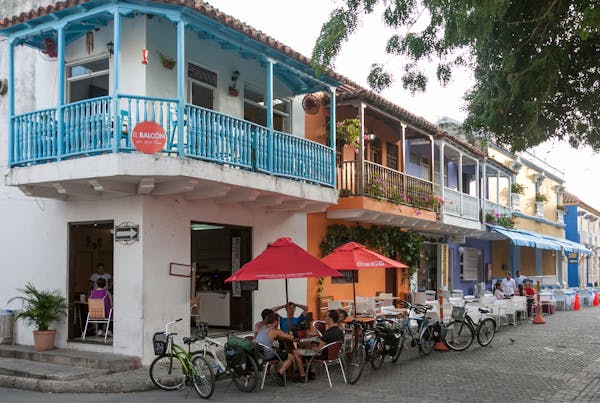"Getsemani is alive. It's real," Colombian entrepreneur Nicolas Wiesner told me as we sat at a table in his Demente Tapas Bar, which he opened in Getsemani in 2013, shunning the pristine colonial center of Cartagena, Colombia.
We were sipping 20-year-old rum waiting for the nightly cast of gorgeous Colombians and in-the-know travelers to fill the place. Locals of all ages had already filled the Plaza Trinidad just outside the door. Children ran around, engaged in games. Adults welcoming the evening cool with cold beers. New life and old life were mixing nicely.
Cartagena de Indias was founded in 1533 on the northern coast of Colombia. Now much of the city is a UNESCO World Heritage Site. Those neighborhoods are sybaritic stunners with some of the most beautifully restored 16th-, 17th- and 18th-century Spanish Colonial architecture in Latin America, all protected by nearly 7 miles of fortified walls, the most extensive in South America and originally built by the Spaniards to keep pirates at bay.
Many historic buildings in the center of Cartagena have been converted into luxurious boutique hotels and acclaimed restaurants. Candy-bright paint jobs and stunning blue skies create a festive, elegant atmosphere, and the languid, Caribbean vibe mingles with the town's colonial gravitas. The late Gabriel García Márquez, Colombia's Nobel Prize-winning author, set many of his novels in Cartagena and kept a home here. Mick Jagger and Justin Bieber also reportedly own property in Cartagena.
This town of 900,000 on Colombia's northwest coast draws tourists from across the globe, including me. But after a week relishing the indulgences of the colonial center, I was ready for a more authentic version of the city.
The Getsemani neighborhood, just a 10-minute stroll from central Cartagena, delivered.
In Getsemani, locals far outnumbered tourists, sidewalks were jammed with residents resting and gossiping in plastic chairs placed just so to catch a breeze, board games were being played in musty tiendas and dusty plazas. Many neighborhood residents have lived here all their lives, and there's a small-town feel to the neighborhood that proud locals happily share with outsiders.
Since the 1990s the number of visitors to Getsemani has increased steadily, though the place isn't overrun with them yet. Backpackers, as usual, lead the way. Now the original budget hostels that opened in this neighborhood rub shoulders with homey midrange hotels and chic boutique lodgings, many at lower prices than their counterparts in central Cartagena.
Not that you'll be spending much time in your hotel room.
Getsemani's charms take place in public, out on its lively, gritty streets. There are no major museums, cathedrals or other traditional sights to see here. In Getsemani, the neighborhood is the attraction.
The "culture quarter"
In 1811 Cartagena became one of the first cities in Colombia to declare independence from Spain, backed up by a group called the Getsemani Lancers, which continued to resist the Spanish until independence was won in 1821. By then, Getsemani was home to craftsmen, freed slaves and merchants, and the area became known as the "popular quarter." Modern Getsemani is more often referred to as the "culture quarter" as poets, painters, photographers and other artistic types move in.
"Getsemani has always been a place associated with people doing things with their hands," explained Rainbow Blue Nelson, the British co-founder and editorial director of the This Is Cartagena website (ticartagena.com) and a Getsemani resident for the past seven years. "More recently Getsemani has become popular with artists like sculptor Alejandro Frieri and graphic artist Ruby Rumie who are looking for cheaper places to have their studios."
Sometimes the neighborhood is their studio. Calle San Juan spans just a few hundred feet, but every inch of the crumbling walls that line the street is covered in paintings, collages, graffiti and appliqué, often with a sociopolitical or historic bent. Roam Getsemani on foot and you'll find many other random signs of charming creativity, like the green balloon painted onto a wall as if it's floating away, string still dangling within reach, or the playful stencil next to the doorknob of a hotel.
Plaza Trinidad is the hub
No matter where you wander, all streets seem to lead to Plaza de la Santísima Trinidad (Plaza Trinidad), which is anchored by a church built in the 17th century. This is the natural hub of the neighborhood, where residents gather day and night to nosh on griddle-cooked chocolo (sweet corn) arepas filled with salty cheese, freshly grilled meat or hot dogs sold by street vendors. It's all lubricated with cold beer from the corner shop and plenty of people-watching. Overseeing the festive proceedings is a group of bronze sculptures in front of the church depicting Pedro Romero, a priest and hero of the 1811 independence movement and one of the Getsemani Lancers.
Though soccer is the undisputed sporting king in Latin America, Colombians on the Caribbean coast also love baseball. In the absence of a proper stadium in or near Getsemani, Avenida del Pedregal is closed to traffic and transformed into a makeshift diamond every Sunday. The centuries-old Spanish-built walls that run along this street provides the perfect vantage point. Just grab a spot and watch the game unfold on the street below you.
As I whiled away a Sunday afternoon watching a ballgame, I was content to let others absorb central Cartagena's colonial beauty and history. They might have been in the center of town, but I felt like I was in the city's true heart.
Writer Karen Catchpole and photographer Eric Mohl have spent more than seven years driving through North, Central and South America. They are still on the road and you can follow their journey on their travel blog http://trans-americas.com/blog.
In heated western Minnesota GOP congressional primary, outsiders challenging incumbent

Minnesota Sports Hall of Fame: A class-by-class list of all members

This retired journalist changed professional wrestling from Mankato

